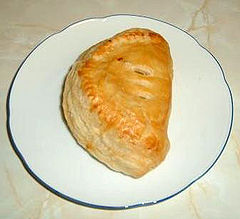- Puff pastry
-
In baking, a puff pastry is a light, flaky, leavened pastry containing several layers of fat which is in solid state at 20 °C (68 °F). In raw form, puff pastry is a dough which is spread with solid fat and repeatedly folded and rolled out (never mashed, as this will destroy layering) and used to produce the aforementioned pastries. It is sometimes called a "water dough" or détrempe.
The gaps that form between the layers are a result of the puff pastry rising as the water evaporates into steam during the baking process. Piercing the dough will prevent excessive puffing, and crimping along the sides will prevent the layers from flaking all of the way to the edges.
Contents
History
Puff pastry seems to be a relative of the Middle Eastern phyllo,[1] and is used in a similar manner to create layered pastries. While traditionally ascribed to the French painter and cook Claude Gelée[2] who lived in the 17th century (the story goes that Gelée was making a type of very buttery bread for his sick father, and the process of rolling the butter into the bread dough created a croissant-like finished product), references appear before the 17th century, indicating a history that came originally through Muslim Spain and was converted from thin sheets of dough spread with olive oil to laminated dough with layers of butter, perhaps in Italy or Germany.
Production
The production of puff pastry dough can be time-consuming, because it must be kept at a temperature of approximately 16 °C (60 °F) to keep shortening from becoming runny, and must rest in between folds to allow gluten strands time to link up and thus retain layering.
The number of layers in puff pastry is calculated with the equation:
l = (f + 1)n
where l is the number of finished layers, f the number of folds, and n the number of times the dough has been folded.
Example: twice-folding (i.e. in three) for four times gives (2 + 1)⁴ = 81 layers. Chef Julia Child recommends 73 layers for regular pâte feuilletée and 730 layers for pâte feuilletée fine (in Volume II of her Mastering the Art of French Cooking textbook).Commercially made puff pastry is available in grocery stores. Common types of fat used include butter, vegetable shortenings, and lard. Butter is the most common type used because it provides a richer taste and superior mouthfeel. Since shortenings and lard have a higher melting point, puff pastry made with either will rise more than pastry made with butter if made correctly; however it will often have a waxy mouthfeel and a more bland flavor.
Puff pastry is not the same as phyllo (filo) pastry, although puff pastry can be substituted for phyllo in some applications. Phyllo dough is made with flour, water, and fat and is stretched to size rather than rolled. Usually when using phyllo dough, a small amount of oil or melted fat (usually butter) is brushed on one layer of phyllo dough and is topped with another layer. This process can be repeated as many times as desired. When it bakes, it becomes crispy but, since it contains somewhat less water, does not expand to the same degree as puff pastry does.
Variants
Puff pastry can also be leavened with baker's yeast to create croissants or Danish pastry, though such doughs are not universally known as puff pastries.
In addition, since the process of making puff pastry is generally somewhat laborious and quite time-intensive, faster recipes (known as "blitz" or "rough puff") are fairly common. Many of these recipes combine the butter into the détrempe rather than adding it in the folding process and are thus similar to a folded short crust.
Common recipes featuring puff pastry
- Turnovers
- Steak and kidney pie and other types of pie
- Sausage rolls
- Beef Wellington
- Strudel
- Miguelitos
References
External links
Categories:- Pastry
- Doughs
Wikimedia Foundation. 2010.



